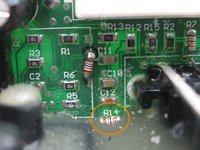Introduction
Error: the speaker is making rumbling noises, or it's dead.
Cause: defective resistor
such SMD resistors usually last forever;
4 of my loudspeakers have already become defective.
This sealant is to blame, it is chemically aggressive and ruins the resistors.
Annoying when the beautiful subwoofer becomes electronic waste because of such a penny article .
What you need
-
-
Unscrew 10 screws
-
Carefully remove the back panel, it sticks a little
-
Unsolder the speaker wire
-
Remove the 'bad' sealant as far as possible on the circuit board, It is not needed where there are no air holes to be sealed.
-
-
-
-
Expose the defective resistors and replace (desoldering is best done with 2 soldering irons)
-
R9 is well hidden, as is R14
-
R8 is hard to get at with a soldering iron, so I found another place to replace it, see Figure 3
-
Depending on how the sealant was applied here, other resistors may also be affected.
-
-
-
Here is an excerpt from the circuit, with the MC33079
-
The 4th OpAmp (pin 12, 13, 14) is the low pass for 'Crossover'
-
MC33079 is supplied with +/- 12 V
-
0 V can be measured at all 4 OpAmp outputs, against ground, with the amplifier switched on. If not then something is wrong.
-
NE5532 is only used to control the LED
-
The power amp is a TDA7296 that runs fine
-
Follow the directions in reverse order to assemble your device
Cancel: I did not complete this guide.
2 other people completed this guide.
Special thanks to these translators:
100%
oldturkey03 is helping us fix the world! Want to contribute?
Start translating ›
7 Guide Comments
Nice guide. I'm having the same symptoms (sub sounds noisy/rumbles) with the Canton AS 60 CX, which I thought was similar to the AS 60 SC, but the PCB is completely different. I bought it used and it has always had this issue. There is the same sealant spilled on some of the resistors; however, a multimeter shows the affected resistors having reasonable values in the 5-14 kilo-ohm range. I also tested the capacitors and they seem to charge/discharge normally. @gottfrieds28407 could you please offer any advice that could help me further diagnose this on the AS 60 CX? I am not overly familiar with audio electronics but I do know my way around simple circuits.
Other things I tried:
- Switching LFE cable to Left instead of Right/Mono
- Checked voice coil/surround/cone - looks healthy and intact
- Every permutation of sub settings on my A/V receiver
Hello, i had to fix my Canton several times, first it was one resistor, then it played fine for a year or so .......
then noise again, next resistor ...... and so on ........ but now i hope i have them all ..........
did you check whether it is the small-signal circuit or the power amp ?
you can find out by disconnecting or shorting the preamp output ......... is the noise gone ?
i found the bad stage by measuring DC voltage at the op amp outputs, with the amp power on
my preamp has plus/minus 12V power supply, so the outputs have 0 V DC and must be steady, not fluctuate
or you could isolate the bad stage by temporary shorting the outputs to ground ......
can you read the resistor values ? the first digits are the value, the last digit is the number of zeros
maybe you could send me a pic of your amp ?
best regards, Gottfried
@gottfrieds28407 thank you for your reply.
...whether it is the small-signal circuit or the power amp ?
you can find out by disconnecting or shorting the preamp output
Without the LFE cable connected, there is no noise. Same if the AV receiver isn't sending anything.
i found the bad stage by measuring DC voltage at the op amp outputs
or you could isolate the bad stage ...
Ah, so there are multiple stages I can test to isolate the issue? That is helpful. I do not know how to tell where the stages are on the PCB, though.
can you read the resistor values ?
It's hard for me to read the resistor stripes because they're so tiny, but at least the resistors covered by the sealant are correct. All the other resistors have sane values in the 1-20kohm range.
maybe you could send me a pic of your amp ?
I took pictures: https://overflod.chary.us/static/as60cx-... You can see on the front-right photos where the sealant is spilled. Maybe a helpful step forward would be if you could point out where on the PCB I can test each "stage".
Thanks,
Zach
looks like there was a misunderstanding: my speaker made noise when it should be silent, while yours makes distortion when playing
is that so ? then it is a different fault, but even easier to find ........
could be just a missing supply voltage ........
The speaker electronics consists of a power amplifier with heat sink, and some small signal stages for the filters, let me call them preamp.
i see your amp uses pin-thru-hole components, while mine uses SMD = surface mount devices
those black 8 pin parts U1, U2, U3 are your preamp stages .... you need to read the part number of those ICs
so we can look them up and find out which pins are the outputs
but first check the power supply ... see pic .....
https://schicks.digital/download/640d842...
those black parts are transistors .... measure the DC voltages at their pins with respect to ground ...... maybe you are lucky ............









